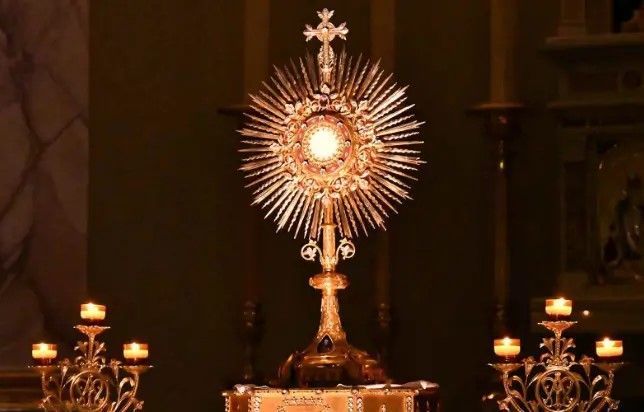Dear Sisters and Brothers in Christ,
Today, the universal Church celebrates our Blessed Mother under the title, Our Lady of Sorrows. That Our Lady can be recognized under so many titles was confusing for me as a boy. I remember asking my mother if Our Lady of Mercy and Our Lady of Loreto were cousins!
Out of all of her titles, Our Lady of Sorrows has to be one of the most somber. And yet it is one of the most popular—especially in parts of the Church that have seen great suffering. She’s the national patroness, for example, of Slovakia. It might have been for that reason that I always associated her with Eastern Europe, but in my years living in Rome I came know that Our Lady of Sorrows was a favorite for the Italians as well—just think about Michelangelo’s famous statue of the sorrowful mother, the Pietà in the Basilica of St. Peter.
There’s an ecclesiastical urban legend that after the Diocese of Greensburg was carved out from Pittsburgh, the new bishop decided that he would try to woo some Pittsburghers across the border by building a beautiful new church just on his side of boundary and dedicating it to “Mother of Sorrows.” The bishop of Pittsburgh, not wanting to be outdone, established a parish just on his side of the same boundary and dedicated it to “Our Lady of Joy,” thinking that people would always choose “joy.” His usually fine intuition was mistaken in this case. Mother of Sorrows is still the larger parish. In the midst of the sufferings that we all experience, the image of a mother who knew suffering herself and now shares our suffering is unfailingly attractive.
Since the earliest days of the Church, followers of Jesus have profited from their meditation on the sufferings endured by Mary. The Servite Fathers, in particular, made popular a spiritual exercise known around the world as the “Seven Sorrows devotion,” leading Catholics to meditate on seven particular instances of sorrow in the life of Mary. The month of September is dedicated to this devotion.
If your pastor wasn’t in too much of a hurry today, you may have sung or recited at Mass the “Stabat Mater,” a hymn that we all know from the Stations of the Cross. It’s a beautiful reflection on Mary standing at the foot of the cross.
As our local Church continues to reel from the tragedy at Annunciation, it’s significant that we have a spiritual mother who herself experienced great suffering and loss. On those occasions in recent days when I have had the occasion to join those praying the rosary in front of Annunciation, I’ve been praying that Our Lady of Sorrows would be particularly close to the moms of Fletcher and Harper, to the moms of all the students at Annunciation, and indeed to parents throughout our Archdiocese.
At a hearing this morning at the Capitol, I was privileged to hear the testimony of a number of Annunciation parents. I was amazed by their strength as well as by their passion and their sorrow and couldn’t help but lift them up to the loving embrace of Our Lady of Sorrows.
There’s wisdom in how our Church calls us to turn to our Blessed Mother not just to share in her celebratory moments (think about the Joyful Mysteries) but also in those moments of mourning and sorrow. May we always be inspired by her ability to be hopeful even in the midst of the tears. Whatever sorrows we may bring, we have a Mother who is waiting with open arms hoping to carry us closer to her son. Our Lady of Sorrows, pray for us.


The Eucharist, From Adoration to Action (Sept. 16)
In this presentation, guest speakers Sister Mary Ann Spanjers, OSF (Congregation of Franciscan Sisters of Christian Charity) and Br. Nathan Linton, OFM Cap. (Franciscan Capuchin) will reveal how everyone can currently live Franciscan Spirituality through an encounter with the God who loves them, particularly in Eucharistic Adoration.

St. Joseph is a model for the Church, which means there’s much profit in modeling one's life after him. In this first quarterly dinner of the 2025-2026 programming year, attendees will be putting on the mind of St. Joseph and learning to think like this great patron. It’s rewarding to do so!

Interfaith prayer service celebrates Harper Moyski’s life, light
Just a few miles from Annunciation’s church in Minneapolis, Father Dennis Zehren, the church’s pastor, stood on a hill overlooking Lake Harriet and the bandshell Sept. 14.
Read the full story from The Catholic Spirit.
Read the full story from The Catholic Spirit.

Pope Leo XIV meets with Bishop Kenney, other bishops during annual formation courses
Bishop Kevin Kenney was among the bishops who met with Pope Leo XIV for the Vatican’s annual formation courses for new bishops.
Get The Catholic Spirit delivered right to your door and subscribe to the weekly newsletter.

Faith in action: Catholic responses to division and crisis
In this episode, Monsignor Martin Schlag discusses the enduring relevance of Catholic social teaching in today’s divided world, exploring themes of work, justice and society in his upcoming lecture. Then, Paul Iovino from the Archdiocese’s Office of Ministerial Standards and Safe Environment shares how Catholic schools and parishes are working to keep families safe following the recent tragedy at Annunciation, Minneapolis.
Visit Practicing Catholic to listen on your favorite podcasting platform. Listen Friday at 9 p.m., Saturday at 1 p.m., or Sunday at 2 p.m. on Relevant Radio 1330AM.
As the second archbishop of the Archdiocese of Saint Paul, Archbishop Dowling led the archdiocese for eleven years. He is known for consolidating the educational system in the archdiocese; building Nazareth Hall, which was a preparatory seminary; founding charitable initiatives and working with the Rural Life Conference.

Archbishop Daniel Austin Dowling
Watch this summer for Archdiocesan Passport Adventure updates and snapshots from our 175-year history in each Weekly Word!
Sent forth by the Holy Spirit to make Jesus known and loved.
777 Forest Street, Saint Paul, MN 55106 | 651-291-4400 | hello@archspm.org
Forwarded this note by a friend? Click here to get Together on the Journey from Archbishop Hebda every week.
Sept. 15, 2025
Sent by Archdiocesan Communications on Monday, September 15 at 8:30PM





